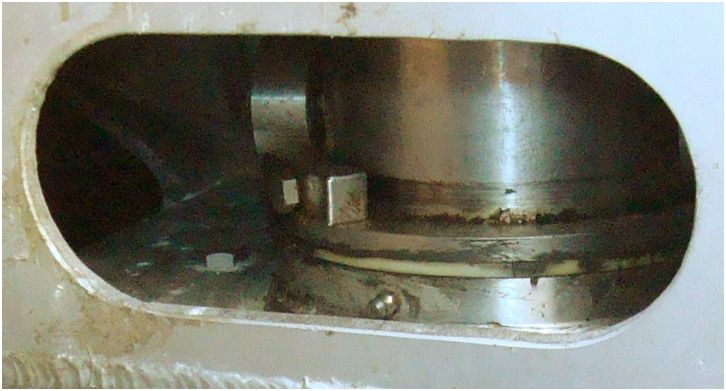Rudder Problems
Posted 20/02/2015 by Lars Ström:
It is suggested that you inspect the upper end of the rudder stock casing closely, as there could also be another reason for the leakage – the lower bearing housing has come loose from the surrounding GRP. In this case the water enters between the steel housing and the GRP laminate around it, and there is a slot visible.
In the photo the steering quadrant is so close to the bearing that it is necessary to take off the quadrant in order to inspect the upper end of the bearing, and determine what the reason is. A leaking slot around the steel as described, or the lip seal around the rudder stock is in bad condition and leaking?
With the quadrant off you should turn the rudder by hand from side to side, and notice if the movement is very smooth and easy, or if it is stiff and uneven, with a varying resistance. In the latter case the lower bearing is not in order and needs to be serviced.
Enclosed pls find the instructions for taking down the rudder, and assumed lip seal dimensions, which should be verified on board.
Pls feel free to ask if you need additional information.
Kind regards, Lars
Preparations
At least 0.8 m free height is required below the lower tip of the rudder blade, and a secure rudder supporting and lifting arrangement with finely adjustable tilt angle is necessary equipment. The support must be able to hold the rudder and stock firmly at about 12 degrees angle while it is lowered or raised in the direction of the stock (pls note not vertically). The rudder tries to swing forward due to its own weight when the upper end of the stock comes out from the upper bearing, but this must not be allowed, as it will damage the lower bearing.
The weight of the rudder is about 150 kg, but if there is water in the blade the weight is higher.
It is helpful to have a short piece, abt 100 mm, of dummy stock with 122 mm diameter ready, to be inserted from above into the upper bearing for preventing the rollers from falling out when the stock is lowered. If it is desired to prevent the lower bearing rollers from falling out the same size of dummy stock can be used there.
Releasing the rudder
Remove the steering quadrant from the stock, and block the stock keyway recess temporarily with a piece of wood or similar. The reason for this is that when the stock is lowered the keyway recess passes through the lower roller bearing, and if one roller decides to jump into the recess this will prevent the stock from moving either way – this would mean big trouble.
At the upper bearing loosen the horizontal hexagonal bolt securing the bearing washer to the stock (in the foreground in the photo) so the washer is free to turn. Lift the rudder a couple of millimeters so the excenters (one of them visible above the horizontal bolt head in the photo) each end of the pin lift free from the washer, and remove both excenters. Loosen the two vertical hexagonal bolts on the upper end of the stock, they secure the horizontal pin going through the stock. Take out the pin. Now the rudder is free to be lowered.

Lip seal
If the purpose is to replace the lip seal at the top of the casing this can now be done. As far as known the seal has the dimensions 122 x 150 x 15 mm according to ISO 6194, pls verify on board, and it should have a stainless spring.
Assembly in reverse order, keep in mind that the stock has to be aligned with the bearings all the time. The purpose of the excenters is to allow height adjustment for the rudder. A small slot against the hull makes the rudder more efficient, but take care to antifoul also the top of the rudder to prevent growth in the slot which can make the rudder stiff.
Lower bearing
It would be a good time to inspect the lower bearing now when the rudder is lowered enabling access from the bottom end of the bearing. This job is most conveniently done after the rudder is removed from the boat. Separate instructions available
*** *** *** *** *** *** *** *** *** *** *** *** *** *** *** *** *** *** *** *** *** *** *** *** *** *** *** *** *** *** *** ***
Posted 06/02/2015 by Lars Ström:
Referring to dropping of the rudder this is a rather demanding job, and a cradle is recommended for supporting and lifting the rudder at exactly the correct angle, otherwise the lower bearing may suffer damage. I see two alternatives here – either hire Nautor’s former best service guy who is now an independent entrepreneur, or make detailed instructions for the yard. The weight of the rudder is 150 kg, but if there is water in the blade it can be more.
*** *** *** *** *** *** *** *** *** *** *** *** *** *** *** *** *** *** *** *** *** *** *** *** *** *** *** *** *** *** *** ***
Posted 06/02/2015 by Matangi:
Since last year I have a significant leakage once the boat reaches speeds close to hull speed. I contacted Nautor and there response was that the lip seal of the rudder shaft needs replacement. I looked at the rudder technical design and checked on the boat. As my local yard is more specialised on motor boats I was wondering if you could provide me with a step by step instruction of taking the rudder off and back on. I would also be interested to understand what device Nautor would use to remove and insert the rudder ensuring save withdrahl and proper alignement in the mounting process. On the technical design it seems that the allignement is not exactly 90 degree to waterline. If hydraulic jacks are used, what is the weight of the rudder? Thank you for your support. If you feel that this should only be done by an experienced sailing yacht yard please let me know as well.
*** *** *** *** *** *** *** *** *** *** *** *** *** *** *** *** *** *** *** *** *** *** *** *** *** *** *** *** *** *** *** ***









